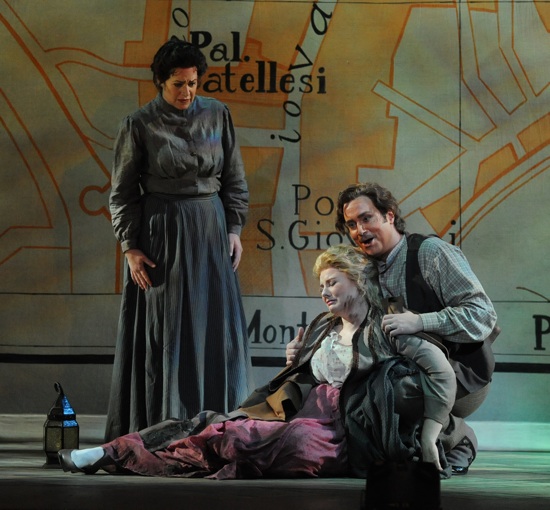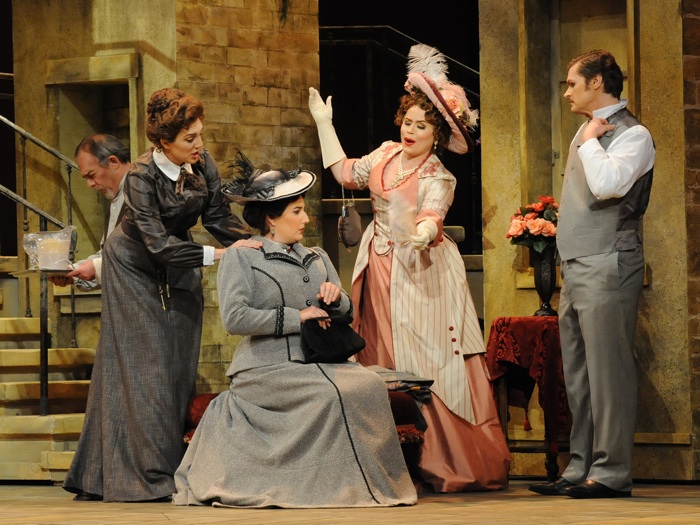A dilettante, a bully and an honest rogue walk into an opera house…
In his first season as the General Director of Opera San Jose, Larry Hancock did something audacious. He was persuaded by the much beloved long-time Director Irene Dalis to present the world premiere of a new opera in his first solo season, the 2014 -15 season. That opera, Where Angels Fear to Tread, had its gala opening at San Jose’s jewel-like California Theatre on Saturday, February 7.
Based on the same-named book by E. M. Forster, Where Angels Fear to Tread is a sweltering combination of English manners and Italian bodice-ripper, deftly turned into an opera by composer Mark Lanz Weiser to a poetic libretto by Roger Brunyate.
When an upper class Englishwoman falls hard for a middle class Italian hunk, she doesn’t ask if he will learn which fork is for oysters and which for salad. Filled with furtive love and sudden tragedy, a tepid brother and a bulldog sister, it is surprisingly comedic.
 The creative team of director Lillian Groag and set designer Michael Ganio created the intimacy and careless exuberance of Italy, abetted by Elizabeth Poindexter’s costumes and lighting by David Lee Cuthbert. Six constructions of stonework, narrow and mythopoetic, became parts of a changing set. Behind them an evening was framed in ripe purples and gold.
The creative team of director Lillian Groag and set designer Michael Ganio created the intimacy and careless exuberance of Italy, abetted by Elizabeth Poindexter’s costumes and lighting by David Lee Cuthbert. Six constructions of stonework, narrow and mythopoetic, became parts of a changing set. Behind them an evening was framed in ripe purples and gold.
This alarming story is not just a collision of cultures, but a collision between 1905 British morality and the wandering spirit of twenty-first century composing. And it’s also a fascinating clash between voice and orchestra. Where the vocal lines were harsh and monochromatic, featuring small modulations and uncomfortable jumps, the music was lush and atmospheric, leading us from scene to scene as if describing an emotional map of the action.
Every now and then Weiser relented and gave us a soaring aria as some character reached for an epiphany, but at other times the vocal ensembles were cacophonous, singing across each other with an almost blind fury.
The strangest of those – and presumably the most unexpected – occurred when the principals sang loudly while one of them held a dog in a basket. That dog suddenly began to howl, much to the delight of the audience.
Conducted with depth and fluidity by Joseph Marcheso, the excellent Opera San Jose orchestra bequeathed a wealth of textures. This is a perfectly sized opera house of 1100 seats with stunning acoustics, and with enough room in the pit for a decent opera orchestra. The strings were silken, the brass impressive, the winds assured and lyrical, and amply spangled with harp notes. In a word, it melted into a romantic past.
Weiser made good use of flute, from the low warbles of the opening to Syrinx-like passages. But nowhere was he as compelling as when he quoted the “mad” aria for flute and soprano from Lucia di Lamermoor. Flutist Isabelle Chapuis was persuasive in her many solos, and soprano Jennie Litster was not only stunning in that aria, but reminded us of the giants on whose shoulders Weiser wrote.
But this is not to say that Weiser’s approach was without merit. His orchestration was appropriate for Forster’s romantic yearnings, with billows of lush strings alternating with rhythmic drums and low brass, all tinted in a neoclassical wash.
Kirk Dougherty played the dilettante brother to the hilt, keeping life at arm’s length. “I was born to honorable failure,” he sang in a clean tenor. “I pass through life without colliding with it.” But later, Italy’s warmth touches his soul. “Beautiful and terrible. These ancient stones are ready to erupt into violence or blossom into beauty.” That last was a leapfrogging duet with Christie Conover, a soprano whose crystalline voice was warmed with mystery or cooled with regret.
Lisa Chavez was impatient and imperial in the role of the sister, a vibrant mezzo with splendid low notes and a dense vibrato. The object of their consternation, their sister Lilia, was sung by Isabella Ivy with huge expressivity, all ringing notes and wanton gestures. Baritone Matthew Hanscom was the object of her love, performing with a gorgeous upper range and implicit violence.
It kept me riveted.
Irene Dalis passed away at the age of 89 this past December 14 after a long career that included 20 years on the stage of the Metropolitan Opera and the creation of her successful opera company (which she headed for thirty years). Based on teaching models in Germany, Opera San Jose offers its young artists year-long contracts, to allow them to develop the multiple roles necessary to launch successful careers. Hancock, also a noted opera lecturer and choral conductor, had worked at Irene Dalis’ side for many years, and the transition appears smooth and successful.
 There are just four more performances: Thursday, Feb. 12 at 8 p.m., Sunday, Feb. 15 at 3 p.m., Friday Feb. 20 at 8 p.m. and Sunday Feb. 22 at 3 p.m.at San Jose’s California Theatre. See www.operasj.org for details and tickets.
There are just four more performances: Thursday, Feb. 12 at 8 p.m., Sunday, Feb. 15 at 3 p.m., Friday Feb. 20 at 8 p.m. and Sunday Feb. 22 at 3 p.m.at San Jose’s California Theatre. See www.operasj.org for details and tickets.
—Adam Broner
Photo top – OSJ guest artist Buffy Baggott as Perfetta, Gino’s housekeeper, watching over OSJ resident artists Isabella Ivy as Lilia Herriton and Matthew Hanscom as Gino Carella, after he has just discovered he is going to be a father in “Where Angels Fear to Tread” at the California Theatre, San Jose. Photo credit: Pat Kirk.
Photo bottom – OSJ resident artist Chloe Smart as Padrona, the innkeeper, Lisa Chavez as Harriet Herriton, guest artist Jennie Litster as the Opera Singer, and OSJ resident artist Kirk Dougherty as Philip Herriton, in “Where Angels Fear to Tread.” Photo credit: Pat Kirk
